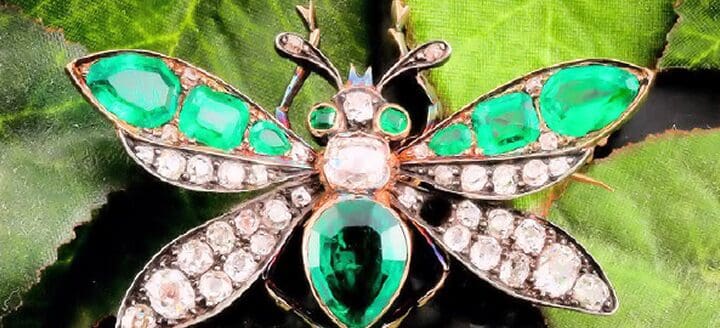History is crawling with jewellery depicting bugs and minibeasts. Our preoccupation with insects and mini-reptiles is thousands of years old. Mankind has always made jewellery to be beautiful, but also often talismanic. In the case of bugs and minibeasts it was believed the jewellery would bring to the wearer the attributes associated with creatures themselves.
Ancient Egyptian scarab images are familiar to most of us. The Egyptians saw the beetle as a symbol of renewal and rebirth. It was believed to be a manifestation of Ra, God of the sun, and the connection was thought to be so powerful that the sun god was considered to be reborn each morning in the form of a winged scarab beetle. This connection with renewal, rebirth, hope and good luck makes it easy to understand why the scarab has such a prominent place in jewellery from ancient times and remains a potent and popular motif to this day.
The interest in all things Egyptian reached a crescendo with the Egyptian Revival, a movement centred around archaeological discoveries in the 19th century, the translation of the Rosetta stone; the construction of the Suez Canal and later, importantly, the discovery of the tomb of Tutankhamun; in which there was, of course, much jewellery, including gold and carved lapis lazuli scarab jewellery which was put into the tomb to help with the transition to the next life.

These events provoked a huge wave of popularity in all things Egyptian; including an interest in snakes which became hugely commercial in the Victorian period. This trend was undoubtedly encouraged by the engagement ring presented to Queen Victoria by Prince Albert in the earlier part of the century. The ring, in the form of a coiled snake, symbolised eternal love with its endless coil. Victoria’s ring was set with an emerald to the head, this being Victora’s birthstone. Known as an ouroboros, the emblematic snake or serpent with its tail in its mouth represents eternity and rebirth. It is a motif which occurs frequently in jewellery, not only in rings but also necklaces and often suspending a heart locket.

The bee was also an important symbol in some early civilisations. It was considered to be sacred and was believed to be a bridge between the natural world and the underworld. The Mayans thought that the bee was a symbol of goodness and would bring life and abundance. Ancient Greeks saw bees as characterising wealth and well-being. The hierarchy of the hive with its Queen and workers as well associations with hard work and individuals working together for communal good added to the imagery. It is easy to see why humankind has been drawn to the bee as a powerful symbol.


The fascination with insects and minibeasts arguably reached its zenith in 19th century. The rise of industrialisation and with it rapid urbanisation meant a large migration to town and city dwelling. This gave rise to a nostalgia for the countryside and nature. People felt that they were falling out of step with nature, and they sought to reconnect through jewellery depicting birds and insects.
It’s easy to see why butterflies, lady birds, and dragon flies lend themselves to beautiful and inspirational jewellery. However, the Victorians embraced all insects, including flies which symbolised secrets and secret keeping; as well as the fly on the wall which hears all but does not divulge. Spiders, similarly, were related to intrigue and secrets and remain a perennially popular motif. You may remember Baroness Hale wore a substantial spider brooch when delivering the verdict on the legitimacy of Boris Johnson’s prorogation of parliament. There was much speculation about what she might have intended to convey. Retrospectively, she said that had she known that people would be looking to interpret the brooch she might have chosen innocuous bunch of flowers. However, the episode serves to show the power of the symbolism. Politicians started to wear spider brooch tee-shirts and the late Ruth Bader-Ginsburg described the stylish arachnid as ‘a symbol of swashbuckling womanhood’. Not bad for a costume piece that had cost £12 from Cards Galore.

We are drawn to wear insect jewellery for its symbolism and meaning, but that is not the whole story. The other side of the equation is how well the subject matter lends itself to interpretation in so many of the media associated with jewellery making; from fine pavé set pieces with emeralds, diamonds, rubies and sapphires, to enamel work, glass, carved stones and pearls. The interpretations are almost limitless, as is the appetite for this jewellery. Although not every interpretation is easy to stomach. Now considered in questionable taste we have also used the body parts of insects themselves as part of the jewels, including butterfly wings and scarab shells. Even this, however, is not as distasteful as the practice of late 19th century Britain, and still current in some parts of South America, of wearing live insects, sometimes caged and occasionally even with jewel encrusted shells.

Notwithstanding the huge influence of the 19th century, insect jewellery continued to be popular in the early 20th century. René Lalique produced some exquisite plique-a-jour butterfly and dragonfly pieces. Child and Child produced realistically designed butterfly pieces in shaded enamels; Boucheron is known for its bee pins and many other important ateliers produced fine gem-set pieces in this genre. These are always in high demand when they come up at auction.

Hello magazine recently announced, ‘Butterfly jewellery is making a comeback’. Good to know, but it’s never really gone away. The Duchess of Sussex often wears a pair of butterfly earrings which used to belong to Princess Diana and other celebrities are pictured with butterfly jewellery; but the truth is that this jewellery has never gone out of fashion. Prices at auction are strong with huge demand for good pieces; but more modest offerings do well too. Whether antique or modern where demand is great, price matches demand. As I have been writing this two of the pieces illustrated, the snake necklace and the costume butterfly brooch went under the hammer. Both realised twice their higher end estimates. Proof, if proof were needed that the world of insects is indeed buzzing – sorry, I couldn’t help myself!
Jenny has been working in the Silver and Jewellery industry for over 35 years, she is a graduate of Reading University where she gained a BA Hons in English literature. She joined Bonham’s auctioneers in Knightsbridge as a post-graduate in the silver, jewellery and clocks and watches departments, specialising in silver and jewellery. Jenny soon rose to the position of deputy head of department.







